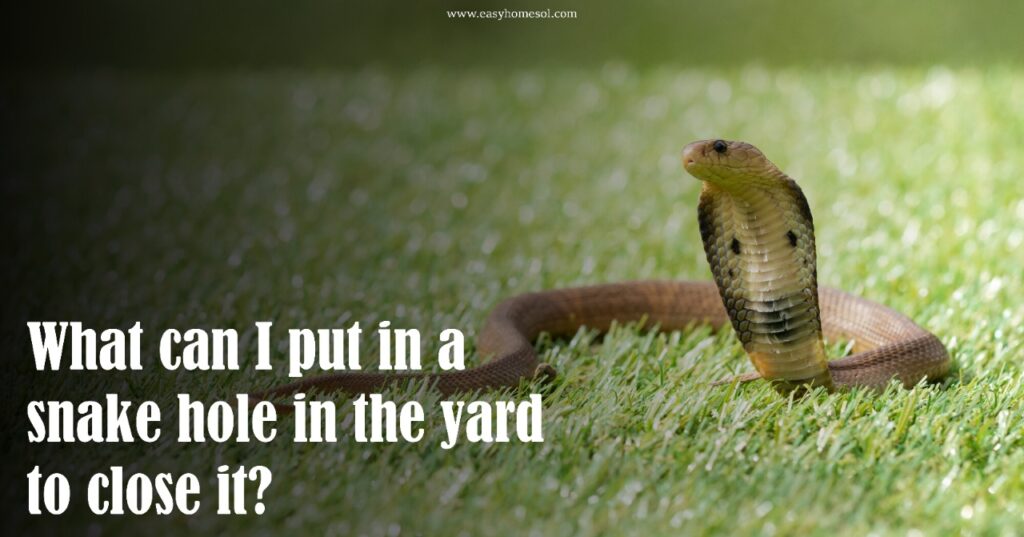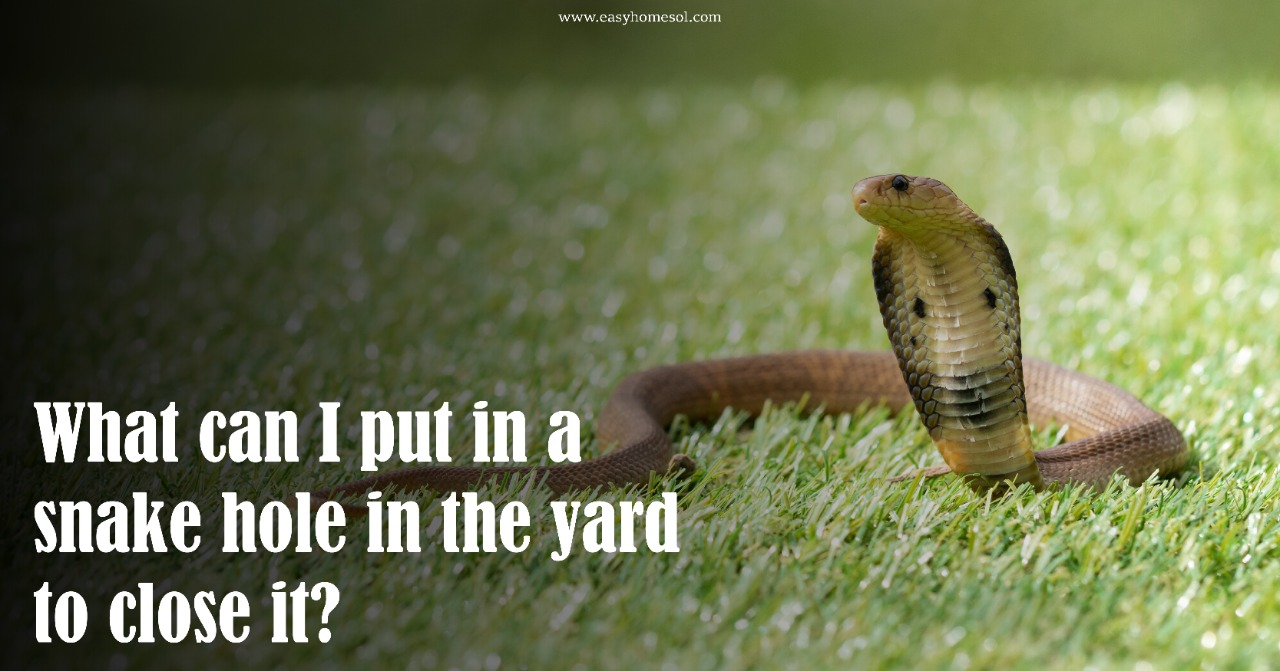
Seeing a snake in your yard can be unwelcome, whether it’s a garter or a venomous snake. Harmless garters snakes are the most common non-venomous snakes found in North America and are often considered pests because they eat rodents like rats, moles, and chipmunks in their burrow. Snakes can potentially cause harm to animals, children, and adults, so it’s essential to close the hole as soon as possible. But what exactly can be used to close a snake hole effectively?
Instead of using harsh chemicals or snake repellent to get rid of the snake, there are other methods that you can use to close snake holes. This article will answer your question, “What can I put in a snake hole in the yard to close it?”
Identify Snake Holes in the yard.
Snakes can be an unwelcome visitor to any home or yard. Unfortunately, they sometimes find their way into yards, creating a hazard for pets and children. Thankfully, you can take some simple steps to identify a snake hole in the yard and prevent them from entering.
First, look carefully around your property for any holes that snakes may be able to enter through. Pay extra attention to areas close to water sources or likely hiding spots such as woodpiles, rocks, and brushy areas. It is best to fill these potential entrances with soil, gravel, or even rocks, as this makes it harder for snakes to access your yard.
If you’ve already identified one or more snake holes in your yard, you need to take action quickly before they become permanent residents!
Safety First: Protective Gear
Safety should be a top priority when handling a snake in your yard. But before you can even consider tackling a snake hole, having the proper protective gear in place is essential. Before you start anything, you should ensure that a snake is living in the hole or is empty. A reliable pair of gloves is essential when dealing with snakes, as they protect your hands from bites and scratches. Sturdy boots are also helpful; they provide extra protection against sharp objects and potential venomous snakes. A long-sleeved shirt and pants will help keep your skin safe from any debris that may be present around the snake hole.
Additionally, having some “snake hook” on hand can make the task easier, allowing you to reach the hole without putting yourself at risk. It would be best if you also took advice from professional pest control.
What can I put in a snake hole in the yard to close it?
We have categorized the most common options for closing a snake hole in your yard. Remember that you must be careful when choosing which option is best for your situation and property, as some can be dangerous. Here is what to pour down a snake hole to close it.
Barrier Method: Construction Materials
When dealing with a snake hole in the yard, it’s essential to ensure the entrance is closed off to prevent further visits from snakes. One possible way of doing this is using construction materials as a barrier. This method can involve filling the opening with screed or concrete, both of which will form a hard surface that is difficult for snakes to break through. Additionally, one could use bricks or large stones as an effective form of blocking off the entrance. These materials are heavy and dense enough that they should remain secure in their position and be more challenging for any pesky snakes to pass through.
Materials such as wire mesh can also be used when trying to close off a snake hole; they provide an extra layer of reinforcement that helps further seal up any gaps around the entrance.
Fill it In: Soil and Rocks.
Soil and Rocks are two of the most common materials used to close a snake hole in a yard. Not only do they provide an effective barrier against snakes entering the area, but they also help restore the ecological balance of the environment. Using soil and rocks as fillers for snake holes is an environmentally friendly way to keep these pesky creatures out of your yard while providing additional support for plant life in your garden.
When filling a snake hole with soil or rock, you must select materials well-suited to the job. You will want to use soil free from chemicals, organic matter, and other contaminants that could harm plants or animals in your yard. Rocks should be carefully selected according to size and weight; gaps between rocks should also be filled with soil.
Plug it Up: Hardware Solutions
If you have noticed a snake hole in your yard, the best solution is to plug it up. Snakes may be fascinating creatures but dangerous if they come too close to humans and family pets. Fortunately, there are several hardware solutions that you can use to fill the snake hole and keep snakes away from your property.
One popular option is to fill the opening with dirt and then cover it with mesh or chicken wire. This creates a barrier between the ground and whatever material you put over it, such as mulch, river stones, or gravel. Additionally, placing these materials on top of the mesh helps discourage snakes from entering your property, as they will not quickly get through the barrier.
Another effective way to block a snake hole is to install a fence around your yard or garden area.
Natural Option: Plants and Greenery
If you have a snake hole in your yard that you need to close, natural options are available to help. Plants and greenery can be used as barriers against snakes while brightening your outdoor space.
Using plants is an environmentally friendly way of closing the snake hole without using potentially hazardous chemicals or materials. The size and type of plant depend on how much the hole needs to be covered and how large the opening is. Dense shrubs like boxwood create a barrier because they send out lateral branches from their base. These branches will grow deeper into the ground over time, making it more difficult for snakes to get through them.
Trees with shallow roots and spreading canopy can also work well as a blockage that restricts movement from one area of your yard to another, creating an extra layer of protection around your garden or property.
What keeps snakes out of your yard?
Snakes can be a nuisance in your yard, and keeping them away is essential. To do this, you should first try to make your yard less inviting for them. Keep your grass trimmed short, remove any piles of debris or logs that could provide a hiding place, and clear away any tall weeds. You may also want to install a fence around the perimeter of your yard if possible.
Additionally, you can use natural repellents such as garlic or cayenne pepper to deter snakes from entering the area. Snakes don’t like these natural repellents.
Finally, you can buy various types of snake traps designed to capture snakes without harming them, which you can then release into the wild far away from home. Taking these steps will help ensure that snakes stay out of your yard.
One great way to keep snakes out of your yard is by using burlap. Burlap can create a barrier that snakes can’t slither through. It’s simple, easy, and relatively inexpensive.
Conclusion: Sealing the Hole Effectively
This article has explored the various solutions to sealing a snake hole in the yard. From using a combination of sand and cement to stuffing it with newspaper, it is essential to find an effective way to close off the entrance and prevent reptiles from inhabiting your property.
The most successful method for sealing up a snake hole depends on the size and shape of the opening. If larger than an inch wide, try filling it up with sand or cement, which can be mixed for extra strength and stability. For smaller openings, stuff newspaper into them until completely packed full – this will help create an airtight seal that snakes cannot penetrate through.
No matter which method you choose, making sure to use quality materials is critical for successfully closing off any snake holes in your yard.
